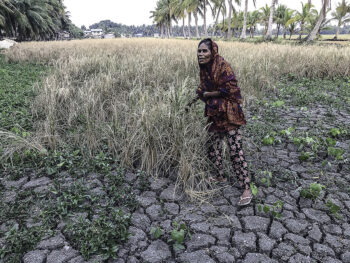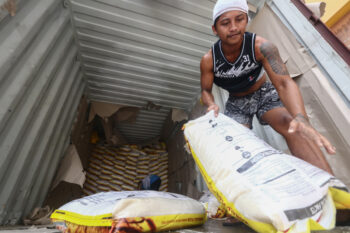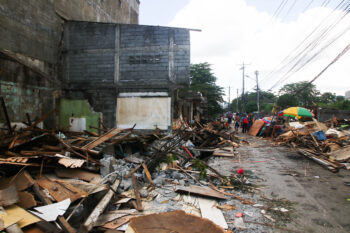ZAMBOANGA CITY (MindaNews/22 May) – This month is etched in our minds because of the midterm national and local elections, with winners proclaimed by the day. Among the so-called “dragon-slayers”, the 77 year-old Palawan native who end up becoming mayor of Rizal in southern Palawan, is one that I prefer the most. His win aligns with this month’s celebration of the National Heritage Month. According to the National Commission for Culture and the Arts, this year’s theme is about “Mga Pinuno para sa Pamana (Leaders for Heritage)”. Hence, this is “a challenge to each and every individual to take lead in preserving and promoting culture heritage”. Otol Odi’s win tells us all that ethnicity or one’s cultural affiliation is not a hindrance to political success, that being ethnic-oriented is to shy away from mainstream politics and more.
There are more than five million Moros in Philippines according to the latest Philippine Statistics Authority census. From the formation of this country to the Moro secessionist movement, there has been an identity crisis from among Filipinos (excluding the Moros) and among Moros (especially those who do not see themselves as Filipinos). Our concepts of each other have largely been formed by colonial powers who see the fragmentation of the different cultural groups across the archipelago as advantageous to the perpetuation of their rule. It also came as no surprise that the “divide and rule” stratagem was successful in keeping the “Indios”, “Moros” and “Naturales” apart and suspicious of each other.
Despite the formation of the Filipino nation-state, old prejudices and stereotypes are still alive, and unfortunately, even used or misused to fan continuing discrimination and advance the selfish agenda of our politicos. The discrimination against Moro employment-seekers and renters, to cite an example, continues and is often heightened by incidents such as the Ampatuan massacre, Sulu and Basilan kidnapping, Mamasapano mis-encounter, Zamboanga and Marawi sieges.
In the age of the global village and social media, just as we take a keen look at this month’s theme, is a challenge to each and every one of us to be active within our individual sphere of influence in promoting and preserving the reign of peace, respect and conviviality in our present society and as an inheritance of our future generations.
Towards this direction, we need to address a number of issues:
To demand and accept as individual obligation that our national narrative has be multicultural, multi-religious and multi-lingual. In fact, it may benefit us to define our nation-state as founded on a tri-national identity and ideology of the Indios, Moros and Naturales of this archipelago at the dawn of our nation-state more than a hundred years ago. Imagine this as akin to the Indonesian’s Pancasila, the five principles that bind the country together.
When looking at identity, we have to transcend this contrasting binary perspective – that a Moro can’t be a Filipino and that to be a Filipino, one has to lose his or her Moro identity. Sometimes, it appears comical when politicos and generals reduce the resolution of the Moro problem as a clarification around the argument between ‘Muslim-Filipino’ or ‘Filipino-Muslim’? Why is it okay and acceptable to embrace Ilokano, Kapampangan, Tagalog or Cebuano and to be Filipino, but not okay to be Moro and Filipino, simultaneously?
Nationality is an ethnic or racial concept while citizenship is a legal or juristic concept. Therefore, a Moro should be able to retain his or her ethnic nationality and Filipino citizenship without a problem, just as the Ilokano, Kapampangan, Tagalog or Cebuano is able to do so. I fear that if we fail to address identity crisis, it will not be far-fetched that we Moros end up like the Rohingyas of Myanmar.
The Bangsamoro Autonomous Region in Muslim Mindanao (BARMM) is the latest episode of our political experimentation to accommodate Moro national tendency within the ambit of the Philippine sovereignty. We wish the BARMM to succeed because even among Moros, we have had enough of the protracted conflict. Conflict can’t be the inheritance of our children and their children.
To heal the wounds of the past, we have to correct historical injustices. The current drive towards transitional justice is just one of the many modes to redress past grievances. I still believe that a formal government apology similar to the “Apology to Australia’s Indigenous Peoples” by the federal government is crucial in acknowledging the wrongs committed in the past before healing may commence. Afterall, many of these wrongs were consequences of biased government policies forced on the Bangsamoro. The commission report on transitional justice is replete with the consequences of government decisions.
After centuries of demonizing each other, we need the same span of time or longer humanizing each other. The quad-media continues to be critical but underutilized toward national healing and reconciliation and in building an inclusive Filipino society. The demonization of Muslims as “Muslim kidnapper”, “Muslim terrorists” and so on need to stop. Government media and cultural agencies need to be proactive and work with Moro communities and explore ways on how to bring the unique heritage into national consciousness and be part of our national identity and heritage. I hope to live to a day in the near future when Filipinos everywhere will view with fair appreciation the struggles of Rizal and Sheikh Makhdum, of Bonifacio and Sultan Kudarat, of Mabini and Amai Pakpak, of Nazaria Lagos and Pangyan Ampay, of Del Pilar and Pangiran Bungso, and so on.
Educating our children and youth in schools need to go beyond earning grades; as much as experiential and transformative process of being able to look at each other as national siblings. We are more than the grades we earn in school. We need to address stereotypes that Moros can only be pictured with their kris ready to go berserk at the slightest provocation. We need to move forward where barong tagalog and baro’t saya are as much as Filipino as our sawwal and sablay. I can’t help it but to say, kudos to the University of the Philippines for adapting our sablay and transforming it into the university gown.
This is about mental models, seeing possibilities beyond the status quo. We know we have reached our desired destination when Moros down south can view with empathy the victims of typhoons in Luzon and the Visayas in much the same way that Filipinos in the northern part of the country may show empathy with Moros displaced or killed in conflict in Mindanao; or when it is safe, fair and comfortable for Moros to live anywhere in the Philippines just as any Filipino can live safely, fairly and comfortably among the Moros in the BARMM.
Change begins with the mind and is sustained by the heart. By being able to accommodate the Moros positively in the minds of the rest of the Filipinos, it becomes easy then to accept them as neighbors and friends in our midst. It is only when we see each other as human that we begin to love and respect as much as we love and respect our self. Roy T. Bennett, author of the book “The Light in the Heart” (2016), once said, “Be the reason someone smiles. Be the reason someone feels loved and believes in the goodness in people”. This is the culture worth preserving, the heritage worth promoting.
(MindaViews is the opinion section of MindaNews. Noor Saada is a Tausug of mixed ancestry – born in Jolo, Sulu, grew up in Tawi-tawi, studied in Zamboanga and worked in Davao, Makati and Cotabato. He is a development worker and peace advocate, former Assistant Regional Secretary of the Department of Education in the Autonomous Region in Muslim Mindanao, currently working as an independent consultant and is a member of an insider-mediation group that aims to promote intra-Moro dialogue).






